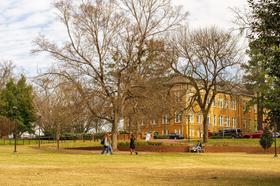Top Rankings
Pawtucket School District ranks among the top 20% of public school district in Rhode Island for:
Category
Attribute
Diversity
Most diverse schools (Top 1%)
Community Size
Largest student body (number of students) (Top 1%)
For the 2025-26 school year, there are 3 public middle schools serving 1,850 students in Pawtucket School District. This district's average middle testing ranking is 2/10, which is in the bottom 50% of public middle schools in Rhode Island.
Public Middle Schools in Pawtucket School District have an average math proficiency score of 8% (versus the Rhode Island public middle school average of 26%), and reading proficiency score of 15% (versus the 30% statewide average).
Minority enrollment is 73% of the student body (majority Hispanic), which is more than the Rhode Island public middle school average of 49% (majority Hispanic).
Overview
This School District
This State (RI)
# Schools
16 Schools
70 Schools
# Students
7,721 Students
33,450 Students
# Teachers
579 Teachers
2,778 Teachers
Student-Teacher Ratio
13:1
13:1
Student By Grade
District Rank
Pawtucket School District, which is ranked within the bottom 50% of all 62 school districts in Rhode Island (based off of combined math and reading proficiency testing data) for the 2022-2023 school year.
The school district's graduation rate of 73% has decreased from 79% over five school years.
Overall District Rank
#42 out of 62 school districts
(Bottom 50%)
(Bottom 50%)
Math Test Scores (% Proficient)
16%
29%
Reading/Language Arts Test Scores (% Proficient)
19%
33%
Science Test Scores (% Proficient)
14%
31%
Graduation Rate
73%
83%
Students by Ethnicity:
Diversity Score
0.71
0.64
% American Indian
1%
1%
% Asian
1%
3%
% Hispanic
37%
31%
% Black
29%
9%
% White
26%
51%
% Hawaiian
n/a
n/a
% Two or more races
6%
5%
All Ethnic Groups
District Revenue and Spending
The revenue/student of $20,765 in this school district is less than the state median of $22,250. The school district revenue/student has grown by 7% over four school years.
The school district's spending/student of $19,264 is less than the state median of $21,467. The school district spending/student has grown by 7% over four school years.
Total Revenue
$160 MM
$2,998 MM
Spending
$149 MM
$2,892 MM
Revenue / Student
$20,765
$22,250
Spending / Student
$19,264
$21,467
Best Pawtucket School District Public Middle Schools (2025-26)
School
(Math and Reading Proficiency)
(Math and Reading Proficiency)
Location
Quick Facts
Rank: #11.
Lyman B. Goff Middle School
(Math: 15% | Reading: 24%)
Rank:
Rank:
3/
Bottom 50%10
974 Newport Avenue
Pawtucket, RI 02861
(401) 729-6500
Pawtucket, RI 02861
(401) 729-6500
Gr: 6-8 | 630 students Student-teacher ratio: 14:1 Minority enrollment: 61%
Rank: #22.
Joseph Jenks Middle School
(Math: 6% | Reading: 15%)
Rank:
Rank:
2/
Bottom 50%10
350 Division Street
Pawtucket, RI 02860
(401) 729-6520
Pawtucket, RI 02860
(401) 729-6520
Gr: 6-8 | 631 students Student-teacher ratio: 14:1 Minority enrollment: 77%
Rank: #33.
Samuel Slater Middle School
(Math: 4% | Reading: 7%)
Rank:
Rank:
1/
Bottom 50%10
281 Mineral Spring Avenue
Pawtucket, RI 02860
(401) 729-6480
Pawtucket, RI 02860
(401) 729-6480
Gr: 6-8 | 589 students Student-teacher ratio: 13:1 Minority enrollment: 82%
Recent Articles

School Vouchers 2025: Updated Pros and Cons
A 2025 update on school vouchers, including benefits, drawbacks, enrollment trends, and how vouchers affect public and private education.

The Role of Arts in Public Schools (2025 Update)
Explore why arts education remains vital in U.S. public schools, with updated data, new policy context, and insights for parents, students, and educators.

The Role of Sports in Public Schools in 2025
How sports in public schools shape learning, health, and community in 2025, with updated data, trends, and expert insights.





